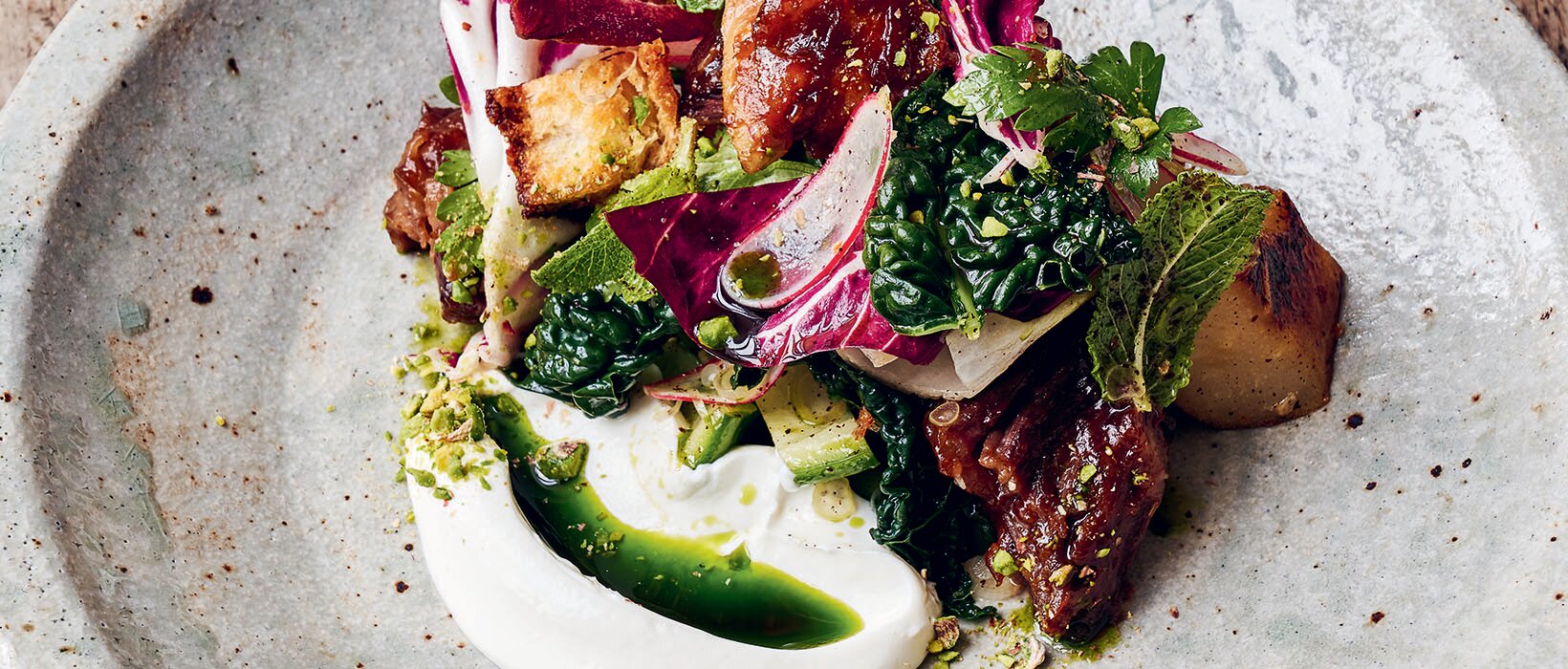Recipe of the week: winter fattoush and tamarind-glazed short rib
This dish is a real feast of contrast. If you have time, cook the ribs low and slow on a barbecue for an extra level of smoky flavour.
Serves 4
- 4-5tbs sumac dressing
- 3-4tbs parsley oil
- 4-5tbs tamarind glaze
- 100g croutons
- 4 beef short ribs
- 4tbs unsalted butter
- 2 pears, cut in half, core removed
- 80g cavolo nero, stalks removed and leaves torn into pieces
- Extra-virgin olive oil
- ½ cucumber, cut in half lengthwise and seeds removed, thinly sliced
- 8 breakfast radishes, finely sliced and placed into iced water
- 4 spring onions, sliced
- ¼ head radicchio, roughly chopped
- 8 leaves yellow chicory, roughly chopped
- 1 small handful of flat-leaf parsley, leaves picked
- 4tbs mint, leaves picked
- Sea salt flakes
- 4tbs thick yogurt
- 4tbs pistachios, toasted and chopped
Heat the oven to 190°C. Prepare the sumac dressing, parsley oil, tamarind glaze (see below for all three), and croutons.
Season the short ribs with fine salt, place into a roasting tin and into the oven for three to four hours or until the meat is falling away from the bone. Pick the meat off the bone into large chunks, once cool enough to handle.
Heat a large frying pan over a medium heat, add the tamarind glaze and short rib pieces along with two tablespoons of the butter. Cook until all of the meat is coated in the glossy glaze. Keep warm.
Put the remaining two tablespoons of the butter into a large, ovenproof frying pan, gently melt and add in the pears, cut-side down, and brown for one minute. Place into the oven for 10 minutes or until golden brown and cooked through. Allow to cool. Cut into large chunks.
Bring a large pan of water to the boil with a little fine salt. Add in the cavolo nero and boil for three to four minutes or until tender. Drain, and allow to cool slightly before dressing with a little salt and olive oil while still warm.
To assemble the salad, in a large bowl mix together the cucumber, cavolo nero, radishes, spring onions, radicchio, chicory, herbs, croutons and pears. Season with sea salt flakes and sumac dressing, to your liking.
To serve, spoon a dollop of yogurt on the plate and place a pile of salad to one side. Scatter over some pieces of short rib, drizzle around the parsley oil and sprinkle the pistachios over the top. I first made this dish for Cook for Syria, to raise funds for Unicef, back in 2016. It is by no means a traditional fattoush, and I encourage you to go out and try the real thing if you get the chance (or prepare the original at home).
Sumac dressing
Zingy and light, this dressing is perfect tossed through salad leaves but also works well with chilli-spiked dishes.
Makes 150ml
- 125ml extra-virgin olive oil
- 1 garlic, finely grated
- 1 lemon, juiced
- 1tbs sumac
Whisk, blend or shake the whole lot in a jar. Season to taste. It will store well in the fridge for two to three weeks.
Parsley oil
Makes 85ml
- 25g parsley, big stalks removed, roughly chopped
- 200ml grapeseed oil
Prepare a bowl of iced water. Bring a pan of water up to a rapid boil, add the herbs and cook for 15 seconds. Take the herbs out and immediately dunk them in the iced water. Squeeze all the excess water from the herbs and roughly chop (reserve the iced water). Make sure you have really squeezed them and they are as dry as they can be.
Place the herbs into a high-speed blender with the oil, and blitz, starting on the lowest setting for 30 seconds, and then on to the fastest setting for two to three minutes, or until the herbs are as fine as they will go. Don’t worry if the oil heats up through blending – this is a normal part of the process and helps the colour of the herbs release into the oil.
At this point you need to decide on whether to leave herby bits in the oil or strain them off. If straining, line a fine sieve with muslin and place over a bowl that fits within the iced water bowl. Pour the oil mix into the lined sieve and leave to drip for one to two hours. If you are leaving the bits in, then simply place the oil into a bowl over the iced water to cool. Store in the fridge for up to a month.
Tamarind glaze
Makes 200g
- 150g tamarind pulp
- 50g dark brown sugar
- 2tbs sherry vinegar
Place the ingredients in a pan over a medium-high heat and simmer for 10 minutes, stirring occasionally. While still hot, push the mix through a fine sieve – this will take a bit of effort.
Discard the seeds and scrape every last bit of the remaining pulp into a container. Store in the fridge (for up to six weeks), or pour into ice-cube trays and freeze.




















